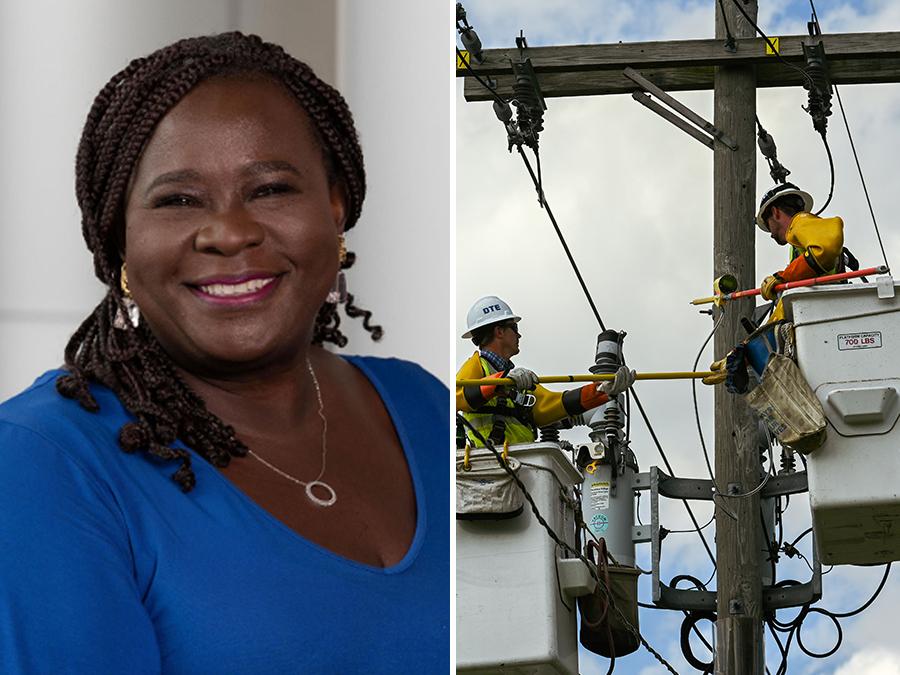Warm weather is right around the corner for Michiganders – as are the summer storms that come with the heat and humidity. DTE Energy’s Cornelia Butler oversees storm preparedness programs for DTE. Here she explains how DTE prepares for extreme weather, so the lights stay on for our customers. Cornelia also shares how DTE staffs for storm restoration –even before the weather hits — so we’re prepared to quickly and safely respond to customer outages.
When does DTE know if a storm will result in outages?
First, we watch the weather up to 14 days of it hitting Michigan. Our meteorologist watches weather from across the country and reviews models that anticipate how our service territory could be affected.
How does DTE staff for expected storms?
When a severe storm hits, it’s all hands-on deck and currently we have over 2,000 trained employees who actively support storm restoration. From employees who actively work to restore power, like our lineworkers, to employees across DTE – from accountants to our Gas crews – who guard wiredowns and assess damage after a storm, we are fully committed to restoring customers’ power as quickly and safely as possible.
Once a storm is anticipated, working with our meteorologist, my team is tasked with identifying the right type and number of resources that will be needed and notifying employees, so they are on standby. We stand up an Incident Command Structure to prepare and organize our resources ahead of the weather. Our crews work in all conditions, but sometimes our Storm Response Teams can be slightly delayed if weather conditions are not safe for them to begin their storm assignments.
What is DTE’s process for restoring power?
Our goal is to always safely restore power to as many customers possible in the shortest amount of time. When many customers experience outages at the same time, it is critical that we follow a prioritized restoration process. First, we secure all downed power lines and the surrounding areas to keep the community and our employees safe. Next, we restore health and safety facilities like hospitals and police stations. Then, we repair the equipment that delivers power to homes and businesses. We start by repairing the equipment that serves areas with the largest number of customers. From there, we work our way down the list from largest to least number of customers impacted until all restorations are complete.
Since DTE’s service territory includes over 40,000 miles of wires and 2.3 million electric customers, assessing storm damage can be a huge job for our Storm Response Teams. Following the initial storm impact, we use a damage assessment strategy to address single outages in parallel with larger outages to ensure we’re efficiently restoring customers as quickly as possible. Once priority customers have been restored, this strategy involves our Storm Response Crews assessing the remaining jobs to ensure we are dispatching the correct crew types to these single locations to make necessary repairs and restore power as quickly and safely as possible.
We understand how frustrating it is for our customers to be without power, and during extreme weather occurrences we also have community van ambassadors that we send to impacted communities to pass out water, ice, phone chargers and flashlights. Our representatives will also share information on restoration estimates, pass out wire down and generator safety information, as the safety of the public and our employees is always a top priority.
What is DTE doing to prevent outages from occurring?
We’re investing more than $1.3 billion annually to build a smarter, stronger grid that will be resilient despite the increasingly extreme weather we’re seeing and provide our customers with the reliable power that they deserve. To continue to improve reliability and build the grid of the future, we have a bold strategy that consists of four prongs: trimming trees, hardening the grid by performing maintenance on our existing infrastructure, rebuilding the oldest sections of our grid and driving toward smart grid technology so we reroute power for customers during outage events so our customers’ lights stay on while we make repairs. Although this work won’t happen overnight, we are committed to making these necessary grid improvements, while also keeping our rates affordable for our customers.
Does tree trimming really improve reliability?
Fallen trees are responsible for 50% of the time our customers spend without power. DTE trimmed more than 6,500 miles of trees in 2022 alone and where we’ve done this work, we know that reliability improves. Customers can help keep their power reliable by keeping trees and branches away from their service drops. Your service drop, which is the line that runs from the utility pole to your home, is your personal connection to the power grid. Keeping branches and other brush away from these lines can prevent an outage or other electrical problems. Since these are energized lines, we highly recommend using a professional tree trimming company to perform any necessary tree trim work.
What can customers do to prevent power outages?
Trees and vegetation can grow into power lines, creating hazardous conditions and causing power outages. Prior to doing any gardening or landscaping, take a few minutes to review DTE’s Right Tree, Right Place Guide at www.dteenergy.com/treetrim so you can do your part by making sure the tree(s) you choose to plant in your yard will add beauty to your property, while promoting electric safety and reliability for your family and neighbors.
